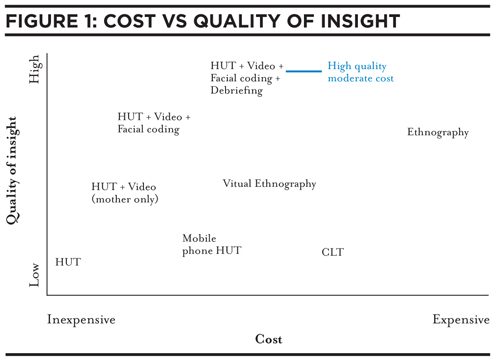Lauren Yourshaw, Payal Kondisetty, Mario da Cruz and Amy Elkes
Infants communicate directly with researchers via mobile video
Parents typically act as purchasing agents for their children, yet their children wield strong influence over the purchase decision. Research on parent-child choices often incorporates both points of view but when it comes to infants, they cannot answer verbal questions or even use visual scales.
Traditional product-acceptance tests ask the mother to indicate how well the child likes a product. This approach is susceptible to mothers’ projecting their own opinions or socially acceptable responses onto the infants’ liking of the product, and memories can be corrupted when the response is recorded sometime after product usage.
Mobile and online technology provides new opportunities to improve or validate the quality of data. We used technology found in almost every mother’s bag – her mobile phone or video camera – and ubiquitous web meeting spaces.
Better, cheaper data
The objective of this study was to evaluate new yogurt product formulations and packaging prototypes to decide whether to launch, modify or reject them.
We considered a central location test (CLT), which would control the environment and protocols while facilitating direct observation of consumption. However, infants might be distracted or alarmed by the unfamiliar environment and the presence of strangers. This method would also be relatively expensive.
A home usage test (HUT) would be less expensive while taking advantage of the infant’s familiar environment. The test could also be conducted over several days, allowing us to test different or replicate products. This would improve the precision of the test and help us discriminate between novelty and true liking but would sacrifice our ability to directly observe the infants’ behaviour. HUT respondents record their data sometime after consumption, and their memories may be corrupted during the delay. Using mobile telephones or smartphones to record the data can reduce this time delay. Although a paper-and-pencil diary is a simpler and proven alternative, a mobile phone is more convenient for on-the-go consumption occasions.
Mobile video recording provides a further improvement since it records the infant’s behaviour in such a way as to virtually eliminate the corruption of a time lag. In the simplest version of this methodology, the mother records her feeding and then reviews it when completing a web survey.
We took this a step further by asking mothers to upload their video and developing a behavioural coding protocol, including facial expressions, to independently measure infants’ acceptance of the products. Next, we called them back to conduct a qualitative debriefing while watching the video through a web-enabled platform to clarify behaviours we observed in the videos.
The video upload technique is similar to “virtual ethnography,” in which participants upload photos and video to an online bulletin board on which a moderator can probe responses with an e-mail-like interface. We preferred telephone conversations coupled with simultaneous viewing of video playback in an online meeting space. This helped us to instantly probe behaviours of interest and rapidly clarify interpretations.
True ethnography would have involved sending researchers to observe consumers in their homes, but this is expensive and could distract infants or even trigger stranger anxiety. Embedding the researcher in the home for an extended time might relieve this anxiety, but at additional expense. Figure 1 compares the cost and quality of insight for several research methodologies.
Balance of power
Even though scales of purchase interest, liking, etc. are commonplace in marketing research, we know that respondents sometimes tell us what they think sounds respectable. Alternately, they might not be aware of their deep motivations, or their memories may have been reconstructed over time. Many alternative methodologies have been used to probe beneath the surface of participants’ responses, including conjoint models, projective questioning, visual stimuli, physiological measurements and facial coding.
Researchers’ skepticism regarding what respondents say is healthy in moderation, but it also lays a trap for the over-confident researcher. To keep ourselves honest, we analysed the results from several points of view: (1) mothers’ interpretations of their infants’ behaviour; (2) researchers’ independent interpretation of this behaviour; and (3) interactive discussions between mothers and researchers.
This was a humbling experience. Even though one of our team members had prior academic research experience with facial coding, and many universal facial expressions of emotion are well documented and expressed early in life, context and individual variation pose real risks of misinterpretation. For example, one infant repeatedly wrinkled his nose. Facial coding would typically flag this as a classic sign of disgust, but talking with the mother revealed that the infant had simply been experimenting with his new “funny face.” Figure 2 shows a few of the signs of rejection we encountered in the study.
Even the best human face readers (such as the fictional sleuths of the television series Lie To Me) have to spend time considering context and a respondent’s personal “baseline” behaviour before jumping to conclusions. This poses an even greater challenge in the case of automated facial coding through technology.
Confident steps
Business decision makers can be skeptical of research that contradicts their preconceptions, and sometimes it is the researchers who need to reexamine their interpretation of results.
In this case, the results pointed to rejection of a product that the decision makers thought mothers would like, so we needed to make an airtight case. Having cross-checked the analysis from several points of view, everybody felt very confident in the results. In addition, playing samples of video helped the team to intuitively understand the data. Thus, we confidently chose the right product formulation to move ahead.
The ethnographic aspect of this study allowed us to make unanticipated observations about product usage, such as how infants handled packaging. Video observation revealed that some package designs fit better in infants’ hands than others, which helped the team to clearly visualise how to improve packaging.
Mobile and online technologies played important roles in aiding respondent recall, detecting respondent bias, gathering unanticipated insights, facilitating cross-checks between different perspectives, and implementing a cost-effective field methodology. All new technology has its flaws, but careful planning allowed us to balance the strengths of several approaches and produce clear guidance to the product-development process.
Lauren Yourshaw is qualitative research consultant, Payal Kondisetty, Ph.D., is senior consultant, and Mario da Cruz is executive vice president at Blueberry. Amy Elkes is consumer insights & innovation manager at Stonyfield.




